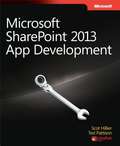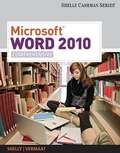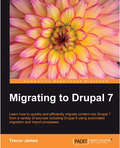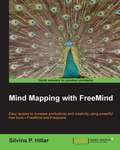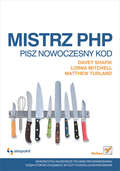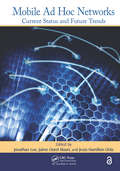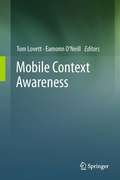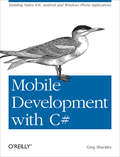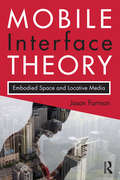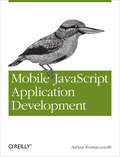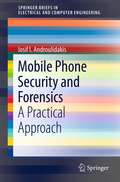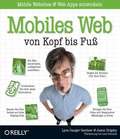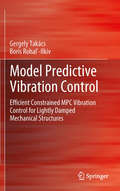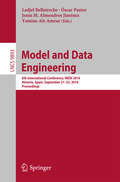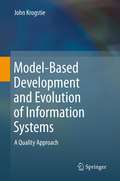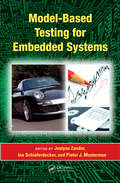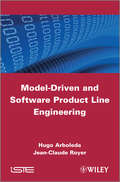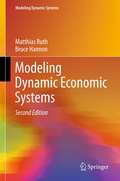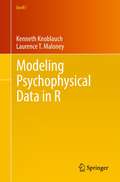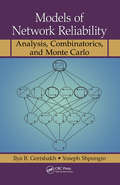- Table View
- List View
Microsoft® SharePoint® 2013 App Development
by Ted Pattison Scot Hillier<p>Take advantage of the most important new concept in Microsoft® SharePoint® 2013--the app. Led by two SharePoint experts, you’ll learn development techniques such as building app lists, creating event handlers, and the major classes in the object model that provide access to content stored in SharePoint.</p>
Microsoft® Word® 2010: Comprehensive
by Gary B. Shelly Misty E. VermaatMicrosoft Office Word 2010: Comprehensive provides a project-based, step-by-step approach to successfully teach students Microsoft Word 2010 skills.
Migrating to Drupal
by Trevor JamesWritten in a friendly and engaging style with practical tutorials and step-by-step examples which show you how to easily migrate your Drupal 6 or WordPress site to Drupal 7. "Drupal 7: A Guide to Migration" is for anyone interested in how to move content from an existing website into the Drupal content management system. Both novice and advanced Drupal users will gain practical hands-on knowledge in how to migrate content into Drupal using this book. You will become experts in using the Feeds module to migrate content, and in packaging your code using Features.
Mind Mapping with FreeMind
by Silvina P. HillarThe book is presented in easy to follow Cookbook recipes covering a wide variety of tasks and applications. The book is for users of FreeMind and FreePlane or new users who would like to explore the world of free mind mapping software. No previous experience is required.
Mining of Massive Datasets
by Anand Rajaraman Jeffrey David UllmanThe popularity of the Web and Internet commerce provides many extremely large datasets from which information can be gleaned by data mining. This book focuses on practical algorithms that have been used to solve key problems in data mining and which can be used on even the largest datasets. It begins with a discussion of the map-reduce framework, an important tool for parallelizing algorithms automatically. The authors explain the tricks of locality-sensitive hashing and stream processing algorithms for mining data that arrives too fast for exhaustive processing. The PageRank idea and related tricks for organizing the Web are covered next. Other chapters cover the problems of finding frequent itemsets and clustering. The final chapters cover two applications: recommendation systems and Web advertising, each vital in e-commerce. Written by two authorities in database and Web technologies, this book is essential reading for students and practitioners alike.
Mining of Massive Datasets
by Anand Rajaraman Jeffrey David Ullman Jure LeskovecThe popularity of the Web and Internet commerce provides many extremely large datasets from which information can be gleaned by data mining. This book focuses on practical algorithms that have been used to solve key problems in data mining and which can be used on even the largest datasets. It begins with a discussion of the map-reduce framework, an important tool for parallelizing algorithms automatically. The authors explain the tricks of locality-sensitive hashing and stream processing algorithms for mining data that arrives too fast for exhaustive processing. The PageRank idea and related tricks for organizing the Web are covered next. Other chapters cover the problems of finding frequent itemsets and clustering. The final chapters cover two applications: recommendation systems and Web advertising, each vital in e-commerce. Written by two authorities in database and Web technologies, this book is essential reading for students and practitioners alike.
Mistrz PHP. Pisz nowoczesny kod
by Davey Shafik Lorna Mitchell Matthew TurlandWykorzystaj najnowsze techniki programowania, dzi?ki którym osi?gniesz wy?szy poziom zaawansowania"Mistrz PHP. Pisz nowoczesny kod" to ksi??ka przeznaczona dla programistów PHP, którzy znaj? ju? podstawy tego j?zyka i chc? rozwin?? swoje umiej?tno?ci, by tworzy? bardziej zaawansowane rozwi?zania. Znajdziesz w niej cenne rady, jak udoskonali? swoje aplikacje serwerowe, oraz wszystko, czego potrzeba do stosowania najefektywniejszych technik obiektowych, zabezpieczania kodu czy pisania programów idealnie spe?niaj?cych swoje zadania. W ka?dym rozdziale poznasz nowe sposoby wykonywania pewnych zada? oraz nowe teorie, le??ce u pod?o?a stosowanych przez Ciebie technik. Dzi?ki lekturze tej publikacji przemienisz si? ze sprawnego programisty w pewnego siebie in?yniera - stosuj?cego najlepsze praktyki programistyczne, pracuj?cego szybko i solidnie. Autorzy przedstawiaj? praktyczne problemy i u?yteczne rozwi?zania, które zaprowadz? Ci? na szczyt kariery! Je?li szukasz mo?liwo?ci scementowania ca?ej swojej wiedzy i chcesz zdoby? solidne podstawy, ta ksi??ka jest dla Ciebie.Dowiesz si? z niej, jak:tworzy? profesjonalne dynamiczne aplikacje w oparciu o obiektowe wzorce programowaniau?ywa? zaawansowanych narz?dzi do oceny wydajno?ci programów, aby zmaksymalizowa? ich mo?liwo?cistosowa? nowoczesne techniki testowania, pozwalaj?ce uzyska? niezawodny kodzabezpiecza? programy przed atakami zewn?trznymi przy u?yciu najskuteczniejszych techniku?ywa? funkcji dost?pnych w bibliotekach i interfejsach programistycznych j?zyka PHP…i wiele wi?cejPraktyczne problemy i u?yteczne rozwi?zania, które zaprowadz? Ci? na szczyt kariery!
Mobile Ad Hoc Networks: Current Status and Future Trends
by Jonathan LooGuiding readers through the basics of these rapidly emerging networks to more advanced concepts and future expectations, this book examines the most pressing research issues in Mobile Ad hoc Networks (MANETs). Leading researchers, industry professionals, and academics provide an authoritative perspective of the state of the art in MANETs. The book includes surveys of recent publications that investigate key areas of interest such as limited resources and the mobility of mobile nodes. It considers routing, multicast, energy, security, channel assignment, and ensuring quality of service.
Mobile Context Awareness
by Tom Lovett Eamonn O'NeillMobile context-awareness is a popular research trend in the field of ubiquitous computing. Advances in mobile device sensory hardware and the rise of 'virtual' sensors such as web application programming interfaces (APIs) mean that the mobile user is exposed to a vast range of data that can be used for new advanced applications. Mobile Context Awareness presents work from industrial and academic researchers, focusing on novel methods of context acquisition in the mobile environment - particularly through the use of physical and virtual sensors - along with research into new applications utilising this context. In addition, the book provides insights into the technical and usability challenges involved in mobile context-awareness, as well as observations on current and future trends in the field.
Mobile Development with C#: Building Native iOS, Android, and Windows Phone Applications (Oreilly And Associate Ser.)
by Greg ShacklesIt’s true: you can build native apps for iOS, Android, and Windows Phone with C# and the .NET Framework—with help from MonoTouch and Mono for Android. This hands-on guide shows you how to reuse one codebase across all three platforms by combining the business logic layer of your C# app with separate, fully native UIs. It’s an ideal marriage of platform-specific development and the "write once, run everywhere" philosophy.By building a series of simple applications, you’ll experience the advantages of using .NET in mobile development and learn how to write complete apps that access the unique features of today’s three most important mobile platforms.Learn the building blocks for building applications on iOS, Android, and Windows PhoneDiscover how the Mono tools interact with iOS and AndroidUse several techniques and patterns for maximizing non-UI code reuseDetermine how much functionality can go into the shared business logic layerConnect to external resources with .NET’s rich networking stackRead and write data using each platform’s filesystem and local databaseCreate apps to explore the platforms’ location and mapping capabilities
Mobile Interface Theory: Embodied Space and Locative Media
by Jason FarmanMobile media – from mobile phones to smartphones to netbooks – are transforming our daily lives. We communicate, we locate, we network, we play, and much more using our mobile devices. In Mobile Interface Theory, Jason Farman demonstrates how the worldwide adoption of mobile technologies is causing a reexamination of the core ideas about what it means to live our everyday lives. He argues that mobile media’s pervasive computing model, which allows users to connect and interact with the internet while moving across a wide variety of locations, has produced a new sense of self among users – a new embodied identity that stems from virtual space and material space regularly enhancing, cooperating or disrupting each other. Exploring a range of mobile media practices – including mobile maps and GPS technologies, location-aware social networks, urban and alternate reality games that use mobile devices, performance art, and storytelling projects – Farman illustrates how mobile technologies are changing the ways we produce lived, embodied spaces.
Mobile JavaScript Application Development: Bringing Web Programming to Mobile Devices
by Adrian KosmaczewskiWhen developing apps for the latest smartphones, you’re faced with several vexing questions. How many platforms do you need to accommodate? What level of support do mobile browsers provide? To help you address these and many other key issues, this guide provides a hands-on tour of the most powerful JavaScript frameworks available today.You’ll build sample apps with jQuery Mobile, Sencha Touch, and PhoneGap to learn the unique advantages—and disadvantages—of each framework. From there, you can determine which one is best for your project. This book is ideal for web developers familiar with JavaScript, HTML, and CSS.Experience the simplicity of jQuery Mobile for building cross-browser applicationsLearn how Sencha Touch’s architecture, widgets, and blazing-fast rendering engine makes it a good choice for enterprise softwareUse PhoneGap to package your web app into a native iOS, Android, or Windows Phone applicationDiscover the impact of various HTML5 features on mobile app developmentPick up JavaScript productivity tips as you delve into its object orientation, closures, and coding conventionsTest and debug your app with a collection of tips, tricks, and tools
Mobile Learning: A Qualitative and Quantitative Analysis for Implementation
by Birendra BistaA dissertation by Birendra Bista on mobile learning, a new paradigm in e-learning.
Mobile Phone Security and Forensics
by I. I. AndroulidakisMobile Phone Security and Forensics provides both theoretical and practical background of security and forensics for mobile phones. The author discusses confidentiality, integrity, and availability threats in mobile telephones to provide background for the rest of the book. Security and secrets of mobile phones are discussed including software and hardware interception, fraud and other malicious techniques used "against" users. The purpose of this book is to raise user awareness in regards to security and privacy threats present in the use of mobile phones while readers will also learn where forensics data reside in the mobile phone and the network and how to conduct a relevant analysis.
Mobiles Web von Kopf bis Fuß
by Lyza Danger Gardner Jason GrigsbyWorum geht es in diesem Buch? Das mobile Web brummt, und so wird es nicht mehr lange dauern, bis mehr Internetnutzer mit Smartphones und Tablets aufs Web zugreifen als mit Desktop-Rechnern. Für Webdesigner kann das nur eines bedeuten: die Ärmel hochkrempeln und ab ins mobile Web! Dieses Buch zeigt Ihnen, wie Sie mit gängigen Webtechnologien mobile Websites und Apps erstellen, die sich sehen lassen können - und das ganz unabhängig davon, ob mit einem Android-Smartphone, einem iPhone oder einem Tablet-PC auf sie zugegriffen wird. Dabei kommen moderne Ansätze wie Responsive Webdesign und smarte Technologien wie WURFL, HTML5, jQuery Mobile und PhoneGap zum Einsatz. Das Buch beschäftigt sich darüber hinaus mit wichtigen strategischen Fragen: Reicht es, eine Website aufs Smartphone zu bringen oder muss eine eigene mobile Website her? Brauchen wir eine Web-App oder soll auf native Features der Mobilgeräte zugegriffen werden? Wieso sieht dieses Buch so anders aus? Wir glauben, dass Sie Besseres verdient haben, als sich im Alleingang durch neuen Stoff zu kämpfen. Anstatt Sie mit länglichen Bleiwüstentexten langsam in den Schlaf zu wiegen, haben wir ein visuell und inhaltlich abwechslungsreiches Buch zusammenge-stellt, in das die neuesten Erkenntnisse der Kognitionswissenschaft und der Lerntheorie eingeflossen sind. Wir wissen nämlich, wie Ihr Gehirn arbeitet.
Model Predictive Vibration Control
by Boris Rohaľ-Ilkiv Gergely TakácsReal-time model predictive controller (MPC) implementation in active vibration control (AVC) is often rendered difficult by fast sampling speeds and extensive actuator-deformation asymmetry. If the control of lightly damped mechanical structures is assumed, the region of attraction containing the set of allowable initial conditions requires a large prediction horizon, making the already computationally demanding on-line process even more complex. Model Predictive Vibration Control provides insight into the predictive control of lightly damped vibrating structures by exploring computationally efficient algorithms which are capable of low frequency vibration control with guaranteed stability and constraint feasibility. In addition to a theoretical primer on active vibration damping and model predictive control, Model Predictive Vibration Control provides a guide through the necessary steps in understanding the founding ideas of predictive control applied in AVC such as: · the implementation of computationally efficient algorithms · control strategies in simulation and experiment and · typical hardware requirements for piezoceramics actuated smart structures. The use of a simple laboratory model and inclusion of over 170 illustrations provides readers with clear and methodical explanations, making Model Predictive Vibration Control the ideal support material for graduates, researchers and industrial practitioners with an interest in efficient predictive control to be utilized in active vibration attenuation.
Model and Data Engineering
by Ladjel Bellatreche Óscar Pastor Jesús M. Almendros Jiménez Yamine Aït-AmeurThis book constitutes the refereed proceedings of the 2nd International Conference on Model and Data Engineering, MEDI 2012, held in Poitiers, France, in October 2012. The 12 revised full papers presented together with 5 short papers were carefully reviewed and selected from 35 submissions. The papers are cover the topics of model driven engineering, ontology engineering, formal modeling, security, and data mining.
Model-Based Development and Evolution of Information Systems
by John KrogstieThis book introduces and describes in detail the SEQUAL framework for understanding the quality of models and modeling languages, including the numerous specializations of the generic framework, and the various ways in which this can be used for different applications. Topics and features: contains case studies, chapter summaries, review questions, problems and exercises throughout the text, in addition to Appendices on terminology and abbreviations; presents a thorough introduction to the most important concepts in conceptual modeling, including the underlying philosophical outlook on the quality of models; describes the basic tasks and model types in information systems development and evolution, and the main methodologies for mixing different phases of information system development; provides an overview of the general mechanisms and perspectives used in conceptual modeling; predicts future trends in technological development, and discusses how the role of modeling can be envisaged in this landscape.
Model-Based Testing for Embedded Systems (Computational Analysis, Synthesis, and Design of Dynamic Systems)
by Justyna ZanderWhat the experts have to say about Model-Based Testing for Embedded Systems: "This book is exactly what is needed at the exact right time in this fast-growing area. From its beginnings over 10 years ago of deriving tests from UML statecharts, model-based testing has matured into a topic with both breadth and depth. Testing embedded systems is a natural application of MBT, and this book hits the nail exactly on the head. Numerous topics are presented clearly, thoroughly, and concisely in this cutting-edge book. The authors are world-class leading experts in this area and teach us well-used and validated techniques, along with new ideas for solving hard problems. "It is rare that a book can take recent research advances and present them in a form ready for practical use, but this book accomplishes that and more. I am anxious to recommend this in my consulting and to teach a new class to my students." —Dr. Jeff Offutt, professor of software engineering, George Mason University, Fairfax, Virginia, USA "This handbook is the best resource I am aware of on the automated testing of embedded systems. It is thorough, comprehensive, and authoritative. It covers all important technical and scientific aspects but also provides highly interesting insights into the state of practice of model-based testing for embedded systems." —Dr. Lionel C. Briand, IEEE Fellow, Simula Research Laboratory, Lysaker, Norway, and professor at the University of Oslo, Norway "As model-based testing is entering the mainstream, such a comprehensive and intelligible book is a must-read for anyone looking for more information about improved testing methods for embedded systems. Illustrated with numerous aspects of these techniques from many contributors, it gives a clear picture of what the state of the art is today." —Dr. Bruno Legeard, CTO of Smartesting, professor of Software Engineering at the University of Franche-Comté, Besançon, France, and co-author of Practical Model-Based Testing
Model-Driven and Software Product Line Engineering
by Jean-Claude Royer Hugo ArboledaMany approaches to creating Software Product Lines have emerged that are based on Model-Driven Engineering. This book introduces both Software Product Lines and Model-Driven Engineering, which have separate success stories in industry, and focuses on the practical combination of them. It describes the challenges and benefits of merging these two software development trends and provides the reader with a novel approach and practical mechanisms to improve software development productivity.The book is aimed at engineers and students who wish to understand and apply software product lines and model-driven engineering in their activities today. The concepts and methods are illustrated with two product line examples: the classic smart-home systems and a collection manager information system.
Modeling Dynamic Economic Systems
by Bruce Hannon Matthias RuthThis book explores the dynamic processes in economic systems, concentrating on the extraction and use of the natural resources required to meet economic needs. Sections cover methods for dynamic modeling in economics, microeconomic models of firms, modeling optimal use of both nonrenewable and renewable resources, and chaos in economic models. This book does not require a substantial background in mathematics or computer science.
Modeling Psychophysical Data in R
by Laurence T. Maloney Kenneth KnoblauchMany of the commonly used methods for modeling and fitting psychophysical data are special cases of statistical procedures of great power and generality, notably the Generalized Linear Model (GLM). This book illustrates how to fit data from a variety of psychophysical paradigms using modern statistical methods and the statistical language R. The paradigms include signal detection theory, psychometric function fitting, classification images and more. In two chapters, recently developed methods for scaling appearance, maximum likelihood difference scaling and maximum likelihood conjoint measurement are examined. The authors also consider the application of mixed-effects models to psychophysical data. R is an open-source programming language that is widely used by statisticians and is seeing enormous growth in its application to data in all fields. It is interactive, containing many powerful facilities for optimization, model evaluation, model selection, and graphical display of data. The reader who fits data in R can readily make use of these methods. The researcher who uses R to fit and model his data has access to most recently developed statistical methods. This book does not assume that the reader is familiar with R, and a little experience with any programming language is all that is needed to appreciate this book. There are large numbers of examples of R in the text and the source code for all examples is available in an R package MPDiR available through R. Kenneth Knoblauch is a researcher in the Department of Integrative Neurosciences in Inserm Unit 846, The Stem Cell and Brain Research Institute and associated with the University Claude Bernard, Lyon 1, in France. Laurence T. Maloney is Professor of Psychology and Neural Science at New York University. His research focusses on applications of mathematical models to perception, motor control and decision making.
Models of Network Reliability: Analysis, Combinatorics, and Monte Carlo
by Ilya B. Gertsbakh Yoseph ShpunginUnique in its approach, Models of Network Reliability: Analysis, Combinatorics, and Monte Carlo provides a brief introduction to Monte Carlo methods along with a concise exposition of reliability theory ideas. From there, the text investigates a collection of principal network reliability models, such as terminal connectivity for networks with unre
Modern Fortran in Practice
by Arjen MarkusFrom its earliest days, the Fortran programming language has been designed with computing efficiency in mind. The latest standard, Fortran 2008, incorporates a host of modern features, including object-orientation, array operations, user-defined types, and provisions for parallel computing. This tutorial guide shows Fortran programmers how to apply these features in twenty-first-century style: modular, concise, object-oriented, and resource-efficient, using multiple processors. It offers practical real-world examples of interfacing to C, memory management, graphics and GUIs, and parallel computing using MPI, OpenMP, and coarrays. The author also analyzes several numerical algorithms and their implementations and illustrates the use of several open source libraries. Full source code for the examples is available on the book's Web site.
Modern Fortran: style and usage
by Norman S. Clerman Walter SpectorFortran is one of the oldest high-level languages and remains the premier language for writing code for science and engineering applications. Modern Fortran: Style and Usage is a book for anyone who uses Fortran, from the novice learner to the advanced expert. It describes best practices for programmers, scientists, engineers, computer scientists, and researchers who want to apply good style and incorporate rigorous usage in their own Fortran code or to establish guidelines for a team project. The presentation concentrates primarily on the characteristics of Fortran 2003, while also describing methods in Fortran 90/95 and valuable new features in Fortran 2008. The authors draw on more than a half century of experience writing production Fortran code to present clear succinct guidelines on formatting, naming, documenting, programming, and packaging conventions and various programming paradigms such as parallel processing (including OpenMP, MPI, and coarrays), OOP, generic programming, and C language interoperability. Programmers working with legacy code will especially appreciate the section on updating old programs.
